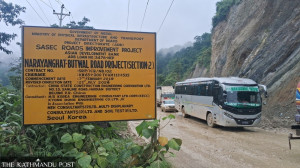Lumbini Province
Scientific forest management in a community forest helps locals of Shitaganga Municipality become self-employed
270 individuals of 32 families in Bhangala have found employment in the community forest.-by-birendra-kc.jpg&w=900&height=601)
Birendra KC
A couple of years ago, Seema Gurung was worried about meeting her household expenses. She didn’t have a source of income and her husband would take on odd jobs to earn a living. But things took a turn for the better for Gurung and her family when Dhirikhola Community Forest adopted the Scientific Forest Management Framework, opening doors to employment for the residents of Bhangala.
Since the community forest in Shitaganga Municipality adopted the new approach a few years ago, it has enabled local residents to earn an income from forest resources. “My husband and I are employed in the forest. We help conserve the forest and earn enough to sustain our livelihood,” said Gurung.
Gurung makes firewood and prunes trees while her husband logs trees and constructs fire lines to conserve the forest from bushfires.
Under the Scientific Forest Management Framework, a community forest takes steps to improve depleting forest quality and productivity and to harness the true economic potential of forest resources with the involvement of locals.
Like Gurung, 270 individuals of 32 families in Bhangala have found employment in the community forest.
Forest officials said that the scientific forest approach enables the locals to reap economic, social and environmental benefits from the forest. According to Jitendra Singh Khadka, division forest officer, his office has improved the forest quality and has increased its productivity by adopting the Scientific Forest Management Framework.
“Users prune mature trees, cut old ones and replace them with new saplings so that they can contribute to the regeneration and sustainability of the forests,” said Khadka.
The community forest, which spreads in around 126 hectares, has brought changes in the lifestyle of forest consumers. Every consumer receives Rs 750 as a daily wage for planting tree saplings, logging trees and loading logs onto vehicles, among other works.
The cumulative income of the forest is Rs 10 million annually, which comes mostly by selling timber and firewood.
“Locals can also take loans from the forest office to start businesses like vegetable farming, goat keeping, poultry and pig and buffalo farms, among others,” said Khadka.
Forest officials have also appointed five forest guards to take care of the forest.
“We have been distributing works and have given the locals the responsibilities to take care of the forest and its resources,” said Narayan Bhusal, chairman of the forest consumers group. “Consumers themselves are involved in planting tree saplings, logging trees and loading logs onto vehicles.”
The villagers have also constructed irrigation canals and drinking water projects and upgraded rural roads from the forest’s income.
Five other community forests in Shitaganga are also on their way to adopting Scientific Forest Management Framework like Dhirikhola Community Forest. Buddha and Banaganga Community Forests are awaiting permission from the Division Forest Office to adopt the Scientific Forest Management process.
“We have already completed all of the due processes to adopt scientific forest management in our community forest,” said Maya Baijali, the chairperson of Banaganga Forest Consumers Group.
According to the scientific forest management framework, there should be only 100 trees in one hectare of forestland.
“More than a hundred trees in one hectare means that the area is too small for trees to grow healthy. That’s why scientific management of forest is necessary for the proper development of trees. Every 10 years, we can make a new work plan for scientific forest management,” said Khadka.




 5.15°C Kathmandu
5.15°C Kathmandu














